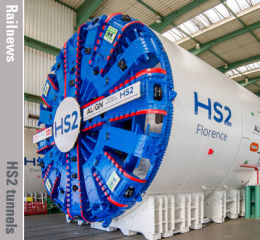Posted 11th August 2020 | 3 Comments
HS2’s giant tunnelling machines prepare for New Year launch

TWO 170m tunnel boring machines named after British women and built in Germany by specialist firm Herrenknecht are set to begin the three-year task of boring the 16km ‘Chiltern tunnels’ for the first phase of HS2 between London and Birmingham in the New Year.
HS2 Ltd has published new pictures of TBM Florence Nightingale before she and her colleague TBM Cecilia Payne-Gaposchkin are dismantled so that they can be brought to England later this year.
Both the women who are commemorated on the 2,000-tonne machines are connected with Buckinghamshire. The founder of modern nursing Florence Nightingale lived for many years at Claydon, close to the future route of HS2, while pioneering astronomer and astrophysicist Cecilia Payne-Gaposchkin was born in the county.
A shortlist of names for the machines was drawn up by pupils at Meadow High School in the London Borough of Hillingdon and Chalfonts Community College in Buckinghamshire. This was followed by a nationwide poll which attracted 4,500 votes, with Florence taking 40 per cent of the vote and Cecilia a close second with 32 per cent.
HS2 Minister Andrew Stephenson said: ‘HS2 will provide better, more reliable connections that truly level up our country, boosting economic growth and sharing opportunities. I want to thank all the students who played a role in this milestone moment, and who will benefit from this high-speed railway for years to come.’
HS2 Ltd chief executive Mark Thurston added: ‘The launch of our first tunnelling machines will be a defining moment in the history of HS2 – and our work to deliver a low carbon, high speed railway that will change the way we travel.’
The first two TBMs will be operated by HS2’s main works contractor, Align JV – a joint venture formed of Bouygues Travaux Publics, Sir Robert McAlpine, and VolkerFitzpatrick.
‘Florence’ is set to be launched early next year, and ‘Cecilia’ will be started up around a month afterwards.
Both machines are specifically designed for the mixture of chalk and flint they will encounter under the Chilterns. Using a ‘continuous boring’ technique, they are expected to take around three years to excavate the 9.1m metre-diameter tunnels which will be lined with concrete as they go. The TBMs will mix the spoil with water to form a slurry which will be pumped back to the main site where it will be treated before being used for landscaping, removing the need for additional lorries on local roads.
Reader Comments:
Views expressed in submitted comments are that of the author, and not necessarily shared by Railnews.

david c smith, Bletchley
Questions arising :-
1/ With covid 19 inspired changes in travel patterns, is anything as radical as the present HS2 plan going to be needed any more( especially the extra capacity) ?
2/ Ought HS2 to be more targetted, to get maximum benefit for minimum cost, rather than trying to serve routes where the potential extra benefits are at best likely to be moderate, and overshadowed by costs?
3/ Should we take note of smaller countries like Switzerland and the Netherlands, where high speed has been rejected in favour of other rail investment ? Rail services in GB are predominantly shorter distance, with only London - Scottish Central Belt and London - Northeast England lying within the 240 to 440 mile range where TGV speeds could bring "sea change".
Henry Peacock, Preston
It's hard to understand how a 16km tunnel is going to blight the wonderful countryside.
And the scheme will certainly not bankrupt Britain. Its construction will offer valuable employment in a post-covid-19, post-Brexit economy. And the completed line will be a valuable asset.
jak jay, surrey
I cannot comprehend as to why this vanity project is going ahead.
Its going to blight the wonderful countryside along the route and bankrupt Britain in the process the people of the UK need HS2 like a hole in the head!